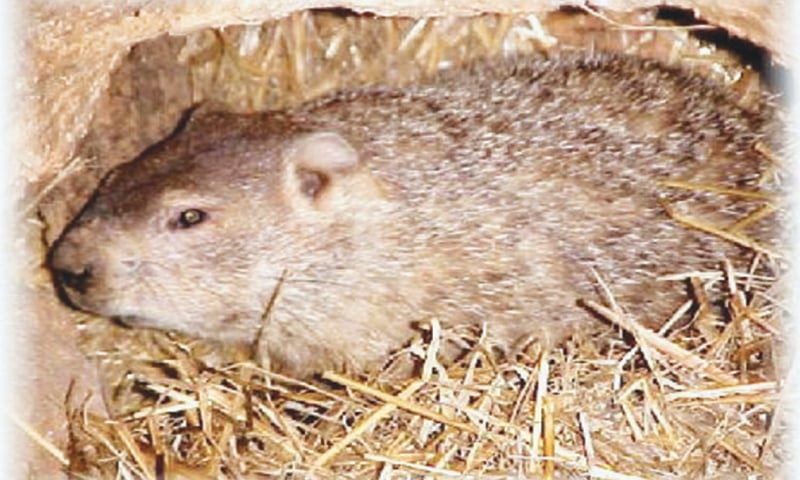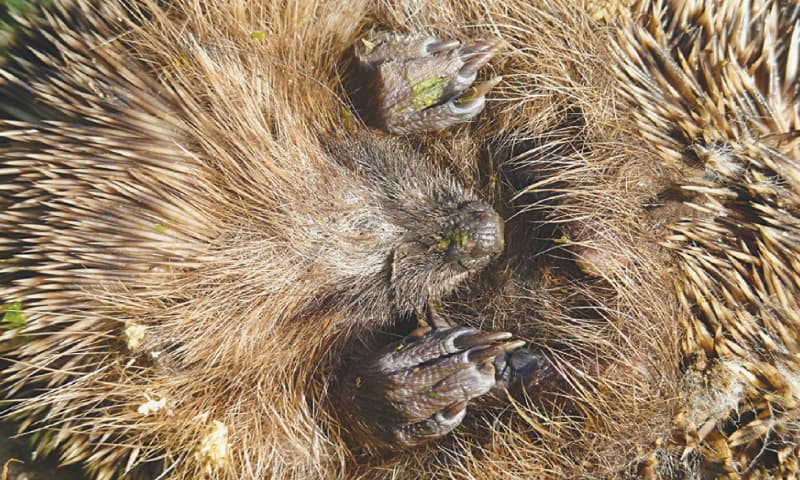Snuggling into a warm bed, under a soft furry blanket, is the most appealing thing to do during winter. But animals are not so lucky to have a fireplace or blanket to keep themselves warm and have to face the harshness of the weather. Many animals live in very cold icy places where even human beings have a tough time keeping warm. So what do they do, how do they survive the harsh, cold winter?
Nature has taken care of this problem by giving them the power to adapt to the changes in weather conditions through something called ‘hibernation’ or winter sleep.
You must have heard about how some animals sleep through the winter to survive the cold and lack of available food when everything freezes. But there is much more to hibernation than just sleeping, a lot of preparation is required by these animals, which starts months in advance of the chilly conditions, and they need special ‘homes’ to pass the months sleeping.
just sleeping, a lot of preparation is required by these animals, which starts months in advance of the chilly conditions, and they need special ‘homes’ to pass the months sleeping.
Today we will look at some animals that hibernate and how they do it to understand this amazing survival technique. There are many such animals so the list is a large one, but here we have only included a few interesting ones.

What is hibernation?
The word “hibernation” comes from the Latin ‘hibernare’, meaning, “to pass the winter”. There are two types of hibernation, true hibernation is when an animal falls into such a deep state of sleep that it appears to be dead. The other state, torpor, is when an animal’s heart rate and temperature reduce, but they are able to move around when needed. The main difference between torpor and hibernation is that during a torpor the animal is easily awoken.
Hibernation was generally considered to be something that mammals did, but now it has been observed and documented in certain species of fish, amphibians, birds and reptiles. Many animals are depended upon a constant energy source to keep their body warm. During harsh weather, such energy source is difficult to find so their body just ‘shuts down’. They stop eating and in many cases stop excreting. All of these things happen so that the animal can use less energy.
There is great decrease in body temperature of the animals, which can be little above the surrounding chilly atmosphere. Breathing and heart rate is exceedingly slow, and they go into such deep sleep that it is difficult to wake them up and they may even appear dead.
During the months before winter, hibernators feed a lot to build up fat in their body so that when they hibernate, they can survive off their fat reserves.
Bears
The largest hibernators are the bears, but they aren’t true hibernators because they go into torpor during winter only if they live in cold areas.
And what make bears unique is that during hibernation they do not eat and drink at all, and excrete rarely, for more than three months to sometimes as long as six months! They can wake up and move around periodically. This allows bears to have their cubs during hibernation. Their heart rates drop from around 40-50 to eight beats per minute.
Only four species of bear are hibernators: American black bear, Asiatic black bear, brown bear and Polar bear.
Much before winter, bears begin eating carbohydrate-rich foods to gain as much as 30 pounds per week. By autumn, they rake leaves, twigs and other plant materials into the den to form a nest. The dens can be in burrows, caves, hollowed-out trees, and rock crevices and typically feature entrance just large enough for a bear to squeeze through and an interior chamber two-and-a-half to five feet wide and two to three feet high. They lie rolled into a tight ball, with their heads between their forepaws and their heavily furred backs exposed to the cold.
Hibernating black bears, particularly mothers with cubs, sleep lightly, they can wake if disturbed, though some may take awhile to do so.
In January, a female black bear may give birth in the den to one or more cubs. She then goes back to sleep, waking up every now and then to tend to the cubs. The cubs, meanwhile, do not hibernate but stay curled up by their mother. By spring, the mum and cubs, which are now about three months old and weigh four to eight pounds, leave the den.
Weight loss is extreme during hibernation but over 99 percent of black bears survive the winter.

Groundhog
Groundhogs, medium-sized members of the squirrel family, are also famous as hibernators since they have traditionally been relied on to predict the weather — a groundhog’s emergence from winter slumber indicates spring’s arrival.
Groundhogs are also called woodchucks. They eat nearly a pound of food per day in fall to help build up fat stores, and dig a deep den that they line with grass or twigs to make it comfortable for hibernation. Babies are born in spring, usually in late March or early April, and this gives them time to mature through the summer and dig their own dens for winter. Groundhogs remain active until the first frost of winter sets in, in October or November. They then crawl down into their deep burrows to hibernate. The hibernation period can last between a couple months to nearly five months, depending on the temperature in the area.
Groundhogs undergo severe changes as they hibernate. From between 80 and 100 beats per minute, a groundhog’s heart rate slows to around four or five beats per minute. The body stays barely above the ambient temperature, falling from 98 degrees Fahrenheit to as low as 38 degrees.
They don’t wake up to eat and they survive on their fat layer.

Frogs and toads
Frogs, such as wood frog, hibernate in colder climates. Some land-dwelling toads also hibernate, with some species hibernating for up to three or four years straight!
They hibernate along creeks and in small crevices of logs and rocks.
Hibernation in frogs is very fascinating as they appear totally dead — frozen with ice crystals in their blood, not breathing and their little hearts even stop beating! When the weather warms up again, they defrost, and their lungs and heart go back into action, and the little frog thrives like before.

Common poorwills
The common poorwill, native to western North America, is the only known bird species to go into true hibernation as they don’t migrate to warmer places. They hibernate when the temperature gets really hot or when food is scare. They can even hibernate while incubating their eggs.
It settles underneath shallow rocks or rotten logs, and stays there for up to five months. Its daily energy needs drop by 93 percent, and when hibernation is over, it needs seven hours to get back to its normal temperature.
Bats
Bats, the only true flying mammals, go into true hibernation, where they go into such a deep sleep that they may appear to be dead.
They can be some of the longest hibernators, if left undisturbed. In the wild, big brown bats spend 64-66 days in hibernation while in captivity one lasted an incredible 344 days! They don’t eat but they do wake up to drink.
Their heart rate drops from 1000 beats per minute to only 25 and some bats only take a breath every two hours!
Bats hibernate in the cavities of large trees, caves, old buildings and wells. Depending on the species, bats either hibernate alone or in groups.

Snail
Not all snails hibernate, but they are found to hibernate whenever the weather is extreme, both during hot and cold temperatures. Their shell serves as their nest in which they retreat. They cover themselves with a thin layer of mucus which protects them from the weather and prevents them from drying out.
Then they close the entrance to their shells with mucus. The mucus hardens to prevent predators from getting in during hibernation. They use almost no energy and don’t have to eat anything at all. In some areas where there is little rain, snails can hibernate for years!

Snakes
Hibernation in reptiles is known as ‘brumation’. Nearly all snakes experience some form of hibernation in winter, though the length depends on the location.
Being cold-blooded, snakes therefore need to find warm hideaways to hibernate, such as holes in the ground or rock crevices. Certain species, like garter snakes, hibernate in groups to preserve heat. These are known as hibernacles, which can hold hundreds of snakes at a time.

Hedgehog
Hibernation in hedgehogs varies between a few weeks to six months, depending on the weather. They tend to maintain a constant body temperature of around 95 degrees Fahrenheit (35 degrees Celsius), which can drop to 43 degrees Fahrenheit (6 degrees Celsius) during hibernation.
They breathe very little and their heart rate drops almost 90 per cent and they may wake up briefly if their body temperatures drop too low. Then their heartbeat picks up to produce more heat to warm their bodies up before going back into hibernation.
Hedgehogs also go into aestivation when the weather is really hot. Aestivation is like hibernation, except that it takes place during hot weather, instead of cold weather.
Bees
Hibernation in bees depends on the species. Honey bees do not hibernate — they stick together in groups in winter and survive on food they’ve collected over summer.
In bumblebees, males and worker bees die when the weather gets too cold but the queen survives by hibernating. She hibernates in a hole in the soil, in rotten tree stumps or under leaf litter. She emerges six to eight months later, builds a nest and creates a whole new team of bees.

Turtles
Different species of turtles hibernate in different ways and for different lengths of time. Since they can’t produce body heat, turtles must hibernate when the temperature drops.
Water turtles bury themselves in mud and leaves at the bottom of a pond. Their body temperature then drops and they stop breathing through their lungs. They have specialised skin cells near their tail opening that provides enough oxygen from the water to survive.
Land turtles hibernate in deep burrow to stay safe from predators and freezing temperatures. Box turtles, found in Southern North America (USA and Mexico), hibernate for three to four months. During this time, the heartbeat drops to just one every five to 10 minutes and they don’t breathe through their lungs, but take in oxygen through their skin. They remain sensitive to the changing environment.

Fat-tailed dwarf lemurs
Most species of lemurs live in tropical climates so they don’t hibernate. The fat-tailed dwarf lemur of Madagascar does hibernates, and for up to seven months.
Madagascar has just two seasons, a cold and dry spell followed by wet and warm weather. Around June the temperature starts to fall, though only down to 30 degrees C, but it is cold enough for these fellows and they hide in tree holes and live off the fat in their tail and lose almost 50 percent of their body weight.
The rains return in November and they are out and about again.
Published in Dawn, Young World, December 24th, 2016















































Dear visitor, the comments section is undergoing an overhaul and will return soon.